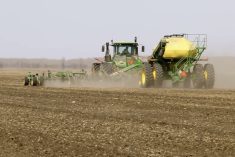Citing recent “reckless use of drones that is putting the safety of Canadians at risk,” the federal government has set up new temporary rules limiting where and when drones can be flown for the heck of it.
Transport Minister Marc Garneau on Thursday announced an interim order with new rules for the recreational operation of model aircraft and of drones weighing more than 250 grams and up to 35 kg.
Recreational drones are now banned from flying higher than 90 metres; from flying within 75 metres of “buildings, structures, vehicles, vessels, animals and the public” which includes “spectators, bystanders or any person not associated with the operation of the aircraft” and over any “open-air assembly of persons.”
Read Also

Trump tariff on Brazilian goods could jack up U.S. burger price
U.S. President Donald Trump’s plan for a 50 per cent tariff on goods from Brazil will likely raise prices for the beef that is used in American hamburgers, traders and analysts said on Thursday, as food manufacturers increasingly rely on imports during a time of declining domestic production.
The new rules also ban drones from flying within nine km of the centre of any airport, heliport or any other site where aircraft take off and land; within nine km of a forest fire area; and within the perimeter of an emergency operation site involving police or first responders.
Recreational drones also may not be flown at night or “in cloud,” the government said.
Recreational drone operators are also now required to mark their drones with their contact information.
Noting Thursday the number of incidents involving recreational drones has “more than tripled” since 2014, Garneau said the new measures, which take effect immediately, will “enhance the safety of aviation and the public while we work to bring into force permanent regulations.”
The temporary rules, which are expected to be in place for up to a year, impose fines for non-compliance, worth up to $3,000 per individual.
The new measures won’t affect operators of drones for “commercial, academic or research purposes,” the government said Thursday.
In those cases, “the rules that are already in place are effective and most commercial users operate their drones in a safe manner.”
Work purposes
Drone use for “work or research purposes” includes the unmanned aircraft’s use in farm work, a Transport Canada spokesperson said Thursday via email.
Thus, farmers or anyone else using a drone for work still must either get a special flight operations certificate (SFOC) from Transport Canada, “unless they meet the strict safety conditions in Transport Canada’s exemptions,” the department said.
SFOCs lay out specific terms for a given operator, which can include limits on maximum allowed altitude, mandatory communications with air traffic control, and minimum required distances from people, buildings and aerodromes.
Exemptions allow work use of drones with a maximum takeoff weight of at least one kg up to 25 kg, with maximum calibrated airspeed of 87 knots or less, as long as the drone is being operated away from “built-up areas, airspace, controlled aerodromes, forest fire areas and other restricted locations.”
Work-related drone use that’s exempt from an SFOC also requires operators to report any drone-related injuries requiring medical attention, as well as any “unintended contact” between a drone and people, livestock, vehicles, vessels or other structures.
Work-related drone uses which fall outside the conditions of those exemptions are subject to requirements for an SFOC, regardless of the drone’s weight.
Transport Canada noted Thursday it’s also proposing changes to federal aviation regulations including new flight rules, aircraft marking and registration requirements, knowledge testing, minimum age limits, and pilot permits for “certain UAV operators.”
Those new rules — which are expected to be published in June for public comment — focus on “smaller” (25 kg or less) drones and unmanned aircraft operated within visual line of sight, whether recreational or non-recreational. — AGCanada.com Network
















